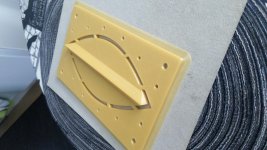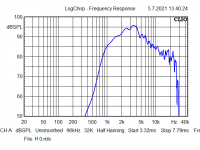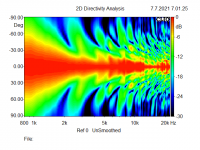The L'Acoustic VDOSC was patented in the 80s iirc; you can see it's shape in the top left. Geometrically, it's perfect, but I wonder if those abrupt transitions will create higher order modes.
I haven't heard anything great from l-acoustics. Just about every speaker they make sounds rough and peaky. Its sad that even coverage is nowadays more important than low distortion and fidelity.
Paraline dreaming...
Not that I am remotely capable of building one, but I recall these old threads and still ponder the idea:
Why can't Danley (or more likely, Patrick) build that unity horn that has (say) similar specs to the SM60? I have the barest understanding of how the Paraline works, so I guess the answer is "you could, but you'd get a 60 degree horizontal and nearly zero degree vertical" horn.
Obviously if this were easy (or even "possible") the man who invented it probably would have made one 😀
Not that I am remotely capable of building one, but I recall these old threads and still ponder the idea:
Why can't Danley (or more likely, Patrick) build that unity horn that has (say) similar specs to the SM60? I have the barest understanding of how the Paraline works, so I guess the answer is "you could, but you'd get a 60 degree horizontal and nearly zero degree vertical" horn.
Obviously if this were easy (or even "possible") the man who invented it probably would have made one 😀
My take
After years of iffing I finally built a "Paraline".
-The curve used is hyperbolic. Target angle 20 degrees vertical.
-Measurements at (too close) 1m.
-Measurement voltage 282.8mV (10mW @ 8ohms, -20dB re 1W).
-The "horn" is just straight side walls with circular rounding. 224x140mm (HxV). *If* I´ll continue with this, the profile must be refined.
Edit: Vertical polar map.
After years of iffing I finally built a "Paraline".
-The curve used is hyperbolic. Target angle 20 degrees vertical.
-Measurements at (too close) 1m.
-Measurement voltage 282.8mV (10mW @ 8ohms, -20dB re 1W).
-The "horn" is just straight side walls with circular rounding. 224x140mm (HxV). *If* I´ll continue with this, the profile must be refined.
Edit: Vertical polar map.
Attachments
Edit two: H and V The other way....After years of iffing I finally built a "Paraline".
-The curve used is hyperbolic. Target angle 20 degrees vertical.
-Measurements at (too close) 1m.
-Measurement voltage 282.8mV (10mW @ 8ohms, -20dB re 1W).
-The "horn" is just straight side walls with circular rounding. 224x140mm (HxV). *If* I´ll continue with this, the profile must be refined.
Edit: Vertical polar map.
have you tried to use Coaxial driver a 5 inch Coaxial? to your paraline projectsI've built a bunch of Paralines*, but I wasn't satisfied with the sound. A lot of dips in the response, and a character that was generally harsh.
I believe the problem is that the sound radiated from the diaphragm hits the bends in the Paraline and is reflected back to the throat. The reflected wave is a higher order mode. HOMs make a horn sound harsh.
So...
I wanted to use some of the same tricks that we use with waveguides to reduce higher order modes. I wanted to use gentle curves to reduce reflections back into the throat.

The first thing I do is draw that familiar 'eye' shape. The point of this shape is to take a spherical wavefront and flatten it into a ribbon shaped wavefront...
* For more info on how Paralines work, read my threads here:
http://www.diyaudio.com/forums/multi-way/133745-i-dont-understand.html
and here: http://www.diyaudio.com/forums/multi-way/217298-square-pegs.html
and here: http://www.diyaudio.com/forums/multi-way/225832-stargate.html
Those are in chronological order, but the real 'eureka' moment was the second thread. Danley has comments in all three, which are valuable insight into the devices.
Hey Patrick if one wanted to build a paraline with a 80hz cutoff how tall and wide could it be and how high can it play also high thick should each layer be I would love to experiment and want to see how big it can get and stay functional let me know or is there a formula that you have to determine high and width would love to know if it's possible
Try something like what's depicted in post #300:
https://www.diyaudio.com/community/threads/danley-signature-series.368860/page-15#post-7104083
https://www.diyaudio.com/community/threads/danley-signature-series.368860/page-15#post-7104083
- Home
- Loudspeakers
- Multi-Way
- An Improved Paraline



